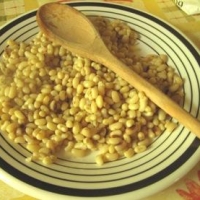Little Beans of Trasimeno other italian beans
From rori76 17 years agoIngredients
- 150 gr Fagiolina del Trasimeno shopping list
- 2 Laurel leaves shopping list
- salt shopping list
- olive oil shopping list
How to make it
- Boil the Fagiolina in cold unsalted water for about 30 min, then add salt and laurel and cook for other 20 min.
- When it’s ready, taste it with just olive oil. The taste is so excellent that no more spices are necessary, but you’re free to try.
People Who Like This Dish 2
- fewls Helotes, TX
- anitagae KS
- peetabear Mid-hudson Valley, NY
- cher3231 Denham Springs, LA
- rori76 Rome, IT
- Show up here?Review or Bookmark it! ✔


 peetabear
peetabear
Reviews & Comments 5
-
All Comments
-
Your Comments
" It was excellent "